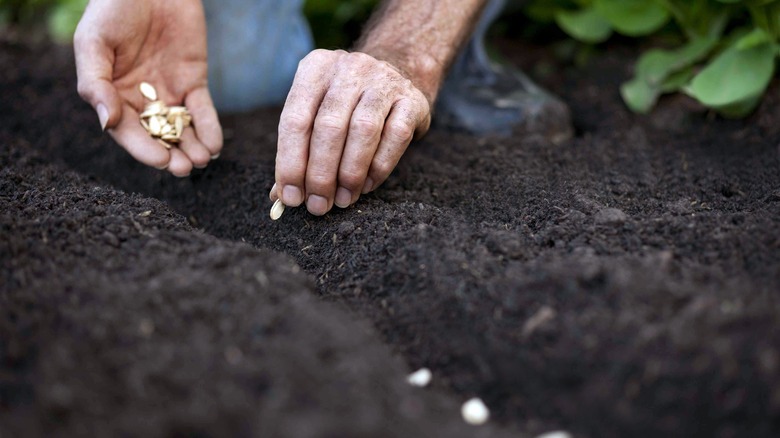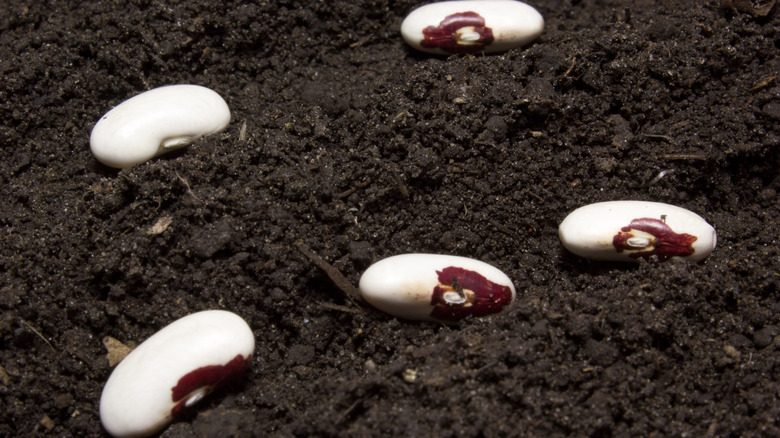What Happens If You Plant A Seed Upside Down?
Starting plants from seeds can be incredibly exciting, though it's not without doubts. From choosing the right site to picking the best time to sow seeds, there's a lot to grapple with. However, the biggest moment of uncertainty strikes just when you're about to sink your seeds into the soil. Should you toss them around willy-nilly, or are there any cardinal directions to follow? Worse, if you mess up and set the seeds upside down, would you irreparably doom their chance at life? Turns out, you can rest easy. Irrespective of the direction you lay down the seeds, they will generally self-correct their course as necessary and grow just fine.
Speaking exclusively to House Digest about this, Nicole Dillon, a micro-flower farmer and owner of Breemar Flower Farm based in Ashland, VA, mentions, "This is really not a worry. Just sprinkle seeds and they will figure their way to grow. Seedlings have a job to do, and they know it!" But how do seedlings figure out their path, and are there any exceptions to this rule? We find out below.
Seeds are attuned to gravity and anchor their roots accordingly
Explaining why home gardeners shouldn't concern themselves over planting seeds upside down, Dillon says in her exclusive House Digest interview, "Seeds have hormones that guide roots to go down and stems to go up." In a phenomenon scientifically known as geotropism, seeds exhibit an intuitive sense of gravity. Once they figure out which direction points down, they redistribute auxins in their root tip. This encourages radicles, or the first roots to grow out from the seed, to redirect their orientation and anchor to the soil. The shoots, simultaneously, curve upwards.
Touching upon what truly plays out in the soil, Dillon elaborates, "Once a seed is planted and receives the moisture it needs, the outer shell softens and cracks open, allowing the cotyledon, or embryonic leaf, to emerge." Cotyledons are the first pair of leaves that sprout from within a seed. They provide it with the necessary sustenance until new leaves develop and start photosynthesizing. "Once the plant receives its first true set of leaves, these baby leaves will die and often fall off shortly after," she explains. "This sometimes causes concern in beginners. [But] it is a normal part of the seed starting process."
Plant bigger seeds on their sides for greater success
Delving deeper in her exclusive interview with House Digest, Dillon insists, "Most seeds don't have a problem with orientation. Bulbs, Tubers, and Corms do have an up and a down way to be situated, but even they figure their way out of the soil regardless." But do bear in mind that there may be a day or two's worth of delay, in some cases.
While small seeds, such as tomatoes, peppers, carrots, and lettuce, largely remain unaffected because of the greater drawdown on their stored reserves, larger seeds may suffer temporary delays. For them, Dillon suggests, "In larger seeds (like beans or corn), you may want to place them on their sides to avoid water pooling on the tip and rotting the seed."
That said, if you insist on sowing seeds in their desired orientation, follow this golden rule: Look for scars left behind on seeds from harvesting — like the belly button on beans — and plant the scarred side face down. New roots (radicles) will shoot out from it. If your seeds sport irregular shapes, the pointiest tip should go first into the ground. Round, small, and dust-like seeds don't have any specific requirements. Should you choose to direct sow seeds in the garden, rather than starting seeds indoors, Dillon advises, "When direct seeding, it's best to overseed. Once the plants get a few inches tall, you can thin them out."

